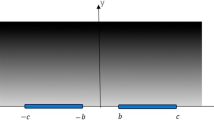Abstract
This paper presents a new continuum shape sensitivity method for calculating mixed-mode stress-intensity factors for a stationary crack in two-dimensional, linear- elastic, isotropic FGMs with arbitrary geometry. The method involves the material derivative concept taken from continuum mechanics, the mutual potential energy release rate, and direct differentiation. Since the governing variational equation is differentiated prior to discretization, resulting sensitivity equations are independent of approximate numerical techniques, such as the finite element method, boundary element method, mesh-free method, or others. The discrete form of the mutual potential energy release rate is simple and easy to calculate, as it only requires multiplication of displacement vectors and stiffness sensitivity matrices. By judiciously selecting the velocity field, the method only requires displacement response in a subdomain close to the crack tip, thus making the method computationally efficient. Seven finite-element based numerical examples, which comprise mode-I and mixed-mode deformations and/or single or multiple interacting cracks, are presented to evaluate the accuracy of the fracture parameters calculated by the proposed method. Comparisons have been made between stress-intensity factors predicted by the proposed method and available reference solutions in the literature, generated either analytically or numerically using various other fracture integrals or analyses. Excellent agreement is obtained between the results of the proposed method and previously obtained solutions. Therefore, shape sensitivity analysis provides an attractive alternative to fracture analysis of cracks in homogeneous and non-homogeneous materials.
Similar content being viewed by others
References
Suresh S, Mortensen A (1998) Fundamentals of Functionally Graded Materials. IOM Communications Ltd., London
Erdogan F (1995) Fracture Mechanics of Functionally Graded Materials. Compos Eng 5(7):753–770
Paulino GH (2002) Fracture of Functionally Graded Materials. Eng Fract Mech 69(14–16):1519–1520
Rao BN, Rahman S (2003) Meshfree Analysis of Cracks in Isotropic Functionally Graded Materials. Eng Fract Mech 70:1–27
Rao BN, Rahman S (2003) An Interaction Integral Method for Analysis of Cracks in Orthotropic Functionally Graded Materials. Comput Mech 32(1–2):40–51
Gurtin ME (1981) An Introduction to Continuum Mechanics. Academic Press, New York, NY
Céa J (1981) Problems of Shape Optimal Design. In: EJ, Céa J, Sijthoff and Noordhoff, Alphen a/d Rijn (eds) Optimization of Distributed Parameters Structures
Haug EJ, Choi KK, Komkov V (1986) Design Sensitivity Analysis of Structural Systems. Academic Press, New York, NY
Fuenmayor J, Dominguez J, Giner E, Oliver JL (1997) Calculation of the Stress Intensity Factor and Estimation of Its Error by a Shape Sensitivity Analysis. Fatigue Fract Eng M 20(5):813–828
Hwang CG, Wawrzynek PA, Tayebi AK, Ingraffea AR (1998) On the virtual crack extension method for calculation of the rates of energy release rate. Eng Fract Mech 59(4):521–542
Giner E, Fuenmayor FJ, Besa AJ, Tur M (2002) An implementation of the stiffness derivative method as a discrete analytical sensitivity analysis and its application to mixed mode in LEFM. Eng Fract Mech 69(18):2051–2071
Feijóo RA, Padra C, Saliba R, Taroco E, Vénere MJ (2000) Shape Sensitivity Analysis for Energy Release Rate Evaluation and Its Application to the Study of Three-Dimensional Cracked Bodies. Comput Methpd Appl M 188:649–664
Taroco E (2000) Shape Sensitivity Analysis in Linear Elastic Fracture Mechanics. Comput Method Appl M 188:697–712
Lee TW, Grosse IR (1993) Energy Release Rate by a Shape Design Sensitivity Approach. Eng Fract Mech 44(5):807–819
Bonnet M (2001) Boundary Element based Formulations for Crack Shape Sensitivity Analysis. Eng Anal Bound Elem 25:347–362
Chen G, Rahman S, Park YH (2002) Shape Sensitivity Analysis of Linear-Elastic Cracked Structures. ASME J Press Vess T 124(4):476–482
Chen G, Rahman S, Park YH (2001) Shape Sensitivity and Reliability Analyses of Linear-Elastic Cracked Structures. Int J Fracture 112(3):223–246
Chen G, Rahman S, Park YH (2001) Shape Sensitivity Analysis in Mixed-Mode Fracture Mechanics. Comput Mech 27(4):282–291
Eischen JW (1987) Fracture of Nonhomogeneous Materials. Int J Fracture 34:3–22
Anderson TL (1995) Fracture Mechanics - Fundamentals and Applications. Second Edition, CRC Press, Boca Raton, Florida
Choi KK, Chang KH (1994) A Study of Design Velocity Field Computation for Shape Optimal Design. Finite Elem Anal Desi 15:317–341
Erdogan F, Wu BH (1997) The Surface Crack Problem for a Plate with Functionally Graded Properties. J Appl Mech. 64:449–456
Kim JH, Paulino GH (2002) Finite Element Evaluation of Mixed Mode Stress Intensity Factors in Functionally Graded Materials. Int J Numer Meth Eng 53(8):1903–1935
Chen J, Wu L, Du S (2000) Element Free Galerkin Methods for Fracture of Functionally Graded Materials. Key Eng Mat 183–187:487-492
Gu P, Dao M, Asaro RJ (1999) A Simplified Method for Calculating the Crack Tip Field of functionally Graded Materials Using the Domain Integral. J Appl Mech 66:101–108
Konda N, Erdogan F (1994) The Mixed Mode Crack Problem in a Nonhomogeneous Elastic Medium. Eng Fract Mech 47(4):533–545
Shbeeb NI, Binienda WK, Kreider KL (1999) Analysis of the driving forces for multiple cracks in an infinite nonhomogeneous plate, Part I: theoretical analysis. ASME J Appl Mech 66:492–500
Shbeeb NI, Binienda WK, Kreider KL (1999) Analysis of the driving forces for multiple cracks in an infinite nonhomogeneous plate, Part II: numerical solutions. ASME J Appl Mech 66:501–506
Author information
Authors and Affiliations
Corresponding author
Rights and permissions
About this article
Cite this article
Rao, B., Rahman, S. A continuum shape sensitivity method for fracture analysis of isotropic functionally graded materials. Comput Mech 38, 133–150 (2006). https://doi.org/10.1007/s00466-005-0726-x
Received:
Accepted:
Published:
Issue Date:
DOI: https://doi.org/10.1007/s00466-005-0726-x




